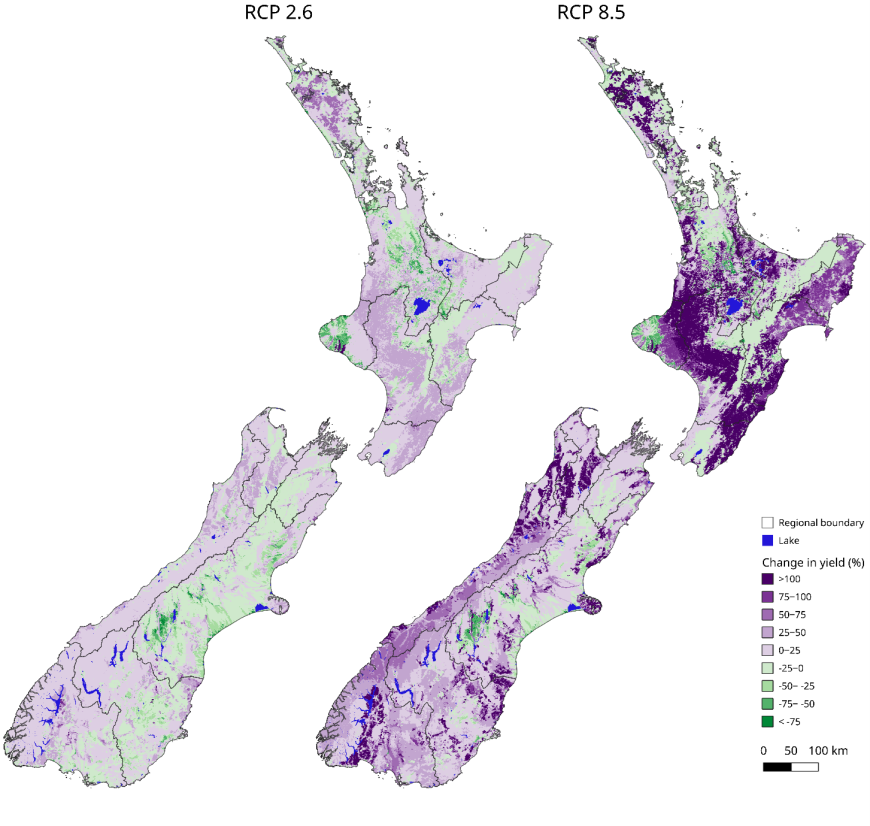- Home
- ...
- Smarter Targeting of Erosion Control (STEC)
- Smarter Targeting of Erosion Control (STEC) News
How will climate change affect erosion and suspended sediment loads across New Zealand?
To address this gap, Manaaki Whenua – Landcare Research, in collaboration with AgResearch and NIWA, produced New Zealand’s first national assessment of the potential impact of climate change on erosion and suspended sediment loads. Future erosion and sediment loads were estimated for mid-century (2040) and late century (2090) based on projected changes in hydro-climatic drivers. Changes in sediment loads were modelled under four potential CO2 concentration pathways. The pathways, referred to as representative concentration pathways, or RCPs, represent radiative forcing based on greenhouse gas trajectories under a mitigation scenario (RCP 2.6), two stabilisation pathways (RCP 4.5 and RCP 6.0), and a continual increase scenario (RCP 8.5).
The results of this modelling highlight clear regional differences in the effects of projected climate change on erosion and sediment loads across New Zealand, and emphasise the impact of higher CO2 concentrations on erosion rates. In the North Island, soft-rock hill country shows the largest erosion response to climate change (Figure 1), which increases under higher CO2 concentrations. In the South Island, the most noticeable differences are seen in the eastern regions (Figure 1), where drier conditions under a low CO2 concentration scenario produce decreasing erosion, whereas wetter conditions under higher CO2 concentration increase erosion.
Up to 28% of the North Island and 8% of the South Island are estimated to experience a two-fold or greater increase in average annual sediment yield (sediment supplied to the channel network) by late century (Figure 1). Regional sediment loads delivered to coastal receiving environments are estimated to increase between 1% and 233% (Table 1). These responses are driven by different directions and magnitudes of change in erosion and the cumulative impact on suspended sediment loads.
This work has been published, open access, in the journal Geomorphology, and can be accessed here for more information.

Figure 1. Percentage change in average annual sediment yield relative to the baseline (1995) under low (left) and high (right) CO2 concentration scenarios by late century (2090). Purple represents an increase in sediment yield, and green represents a decrease. (Source: Neverman et al. 2023).
For regional applications, erosion processes are best represented by the SedNetNZ model using region-specific data, such as spatial information on erosion mitigation works by councils. SedNetNZ has been used to assess the impacts of climate change on erosion and sediment loads in the Wairoa catchment (Hawke’s Bay) and the Manawatū-Whanganui region (Smith et al. 2022; Vale et al. 2022), with results helping to inform implementation of the NPS-FM 2020 (Vale et al. 2022).
Table 1. Baseline total suspended sediment loads supplied to the coast of each region, and the proportional change in total suspended sediment loads under future climate scenarios. The RCPs represent a CO2 mitigation scenario (RCP 2.6), two stabilisation pathways (RCP 4.5 and RCP 6.0), and a continual increase scenario (RCP 8.5). (Source: Neverman et al. 2023)
| 2040 change in load (%) | 2090 change in load (%) | ||||||||
|---|---|---|---|---|---|---|---|---|---|
| Region | Baseline load (Mt/yr) | RCP 2.6 | RCP 4.5 | RCP 6.0 | RCP 8.5 | RCP 2.6 | RCP 4.5 | RCP 6.0 | RCP 8.5 |
| Auckland | 0.47 | 18 | 24 | 25 | 36 | 14 | 30 | 45 | 75 |
| Bay of Plenty | 6.2 | 16 | 21 | 21 | 29 | 13 | 25 | 37 | 56 |
| Canterbury | 9.4 | 6 | 7 | 11 | 10 | 2 | 8 | 16 | 26 |
| Gisborne | 28 | 23 | 31 | 30 | 40 | 20 | 36 | 53 | 81 |
| Hawke's Bay | 10 | 24 | 29 | 30 | 41 | 19 | 38 | 54 | 84 |
| Manawatū-Whanganui | 12 | 33 | 45 | 44 | 59 | 29 | 55 | 83 | 127 |
| Marlborough | 1.2 | 7 | 6 | 7 | 4 | 1 | 5 | 10 | 18 |
| Nelson | 0.036 | 9 | 13 | 20 | 6 | 2 | 11 | 23 | 39 |
| Northland | 14 | 59 | 86 | 88 | 113 | 49 | 105 | 153 | 233 |
| Otago | 1.6 | 13 | 16 | 16 | 21 | 8 | 21 | 37 | 55 |
| Southland | 4.1 | 12 | 12 | 17 | 15 | 9 | 14 | 31 | 47 |
| Taranaki | 2.8 | 21 | 32 | 30 | 42 | 20 | 39 | 60 | 95 |
| Tasman | 2.4 | 13 | 15 | 21 | 21 | 10 | 20 | 31 | 46 |
| Waikato | 5.9 | 28 | 42 | 40 | 57 | 25 | 53 | 75 | 121 |
| Wellington | 5.2 | 36 | 47 | 47 | 61 | 33 | 58 | 84 | 127 |
| West Coast | 66 | 12 | 15 | 22 | 23 | 7 | 18 | 31 | 52 |
References
Neverman AJ, Donovan M, Smith HG, Ausseil A-G, Zammit C 2023. Climate change impacts on erosion and suspended sediment loads in New Zealand. Geomorphology 427: 108607. https://doi.org/10.1016/j.geomorph.2023.108607
Smith HG, Vale S, Neverman AJ, Robson-Williams M, Harris L 2022. Climate change impacts on sediment loads in the Wairoa catchment, Hawke’s Bay. Manaaki Whenua ‒ Landcare Research contract report LC4121 prepared for Our Land and Water National Science Challenge.
Vale S, Smith HG, Neverman AJ, Herzig A 2022. Application of SedNetNZ with SLUI erosion mitigation and climate change scenarios in the Horizons region to support NPS-FM 2020 implementation. Manaaki Whenua ‒ Landcare Research contract report LC5033 prepared for Horizons Regional Council.
Key contacts

